
Crow Indians, Sheridan Stampede, July, 1914
Rodeos have been a part of the American West since at least
1869 when a Fourth of July contest for the title "Champion Bronco Buster of the Plains" was held
in what is now Deer Trail, Colorado. By the end of the 19th Century local festivals featuring parades, rodeos,
county fairs had become a distinctively American phenomenon. Just about every small
down celebrated some local distinction, often portraying a fictionalized local legend. An example is
Lusk's "Legend of Rawhide," providing an explanation (of sorts) as to the naming of
Rawhide Buttes. Examples from elsewhere include New Orlean's Mardi Gras,
Tampa's Gasperilla and Pasadena's Rose Parade. Webmaster's wife came from a small town which
had its annual "Peanut Exposition." Almost all towns in Wyoming have had its festival or rodeo. The most
famous, Cheyenne's Frontier Days, was inspired by Greeley, Colorado's Potato Day. Cheyenne's was not, however,
the first in Wyoming. To that honor goes Lander which had its first rodeo in 1896, a year before
Cheyenne. Other rodeos, often held in conjunction with the Fourth of July and some of which are
gone now, included those of
Cody started in 1903, the Lusk Roundup, Jackson Frontier Days, Story Wild West
Rodeo, Moorcroft Frontier Days, Pinedale Roundup, the Casper Stampede and rodeos in Dubois, Shoshoni and
Encampment. In some other
parts of the country unfortunately such activities have declined as local citizenry either don't
have the time or have become too sophisticated for such activities. Fortunately, in Wyoming such traditions
are alive and well. Where else can one find something so elegant as Rawlins'
annual "Outhouse Race," held in July of each year?
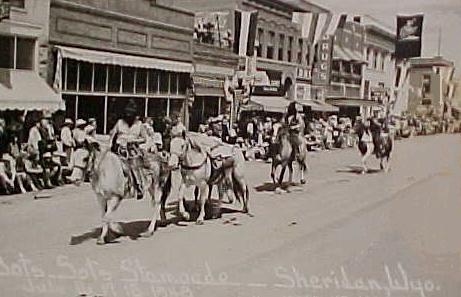
Crow Indians, Stampede, July,1948
Compare with photo at top of page.
The fact that the rodeo and the Fourth of July are intertwined and represent the
epitome of the American cowboy is best illustrated by the legend of Pecos Bill first written of
by Edward O'Reilly in 1923 in the Century Magazine and later popularized by Iowa lawyer Harold W. Felton.
It will be recalled that Pecos Bill was reared by coyotes, was able to tame mountain lions and rattlesnakes, and had
a horse, "Widow-Maker" which nobody could ride but Bill. The centerpiece of the tale was, however, the
Fourth of July Rodeo at which Bill rode a cyclone, not any cyclone, but The Cyclone. The Cyclone
had become jealous of the attention given by the townspeople to the Rodeo and Bill and
decided to break things up. Bill's response was to rope The Cyclone and ride him -- the most bodacious
bronco busting rodeo there ever was.
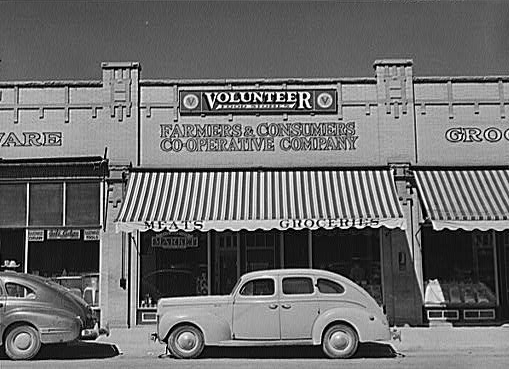
Sheridan, 1941, photo by Marion Post Wolcott.
Marion Post Wolcott (1910-1990) was a compatriot of Arthur Rothstein,
discussed on the Medicine Bow page, and of Russell Lee, discussed with
regard to Cambria, in the Farm Security Administration. During the mid-1930's,
she worked in Germany and Austria and, as a result of her exposure to the
Nazi movement, became an ardent activist in leftist causes. Following, the
return of Paul Strand from the Soviet Union, Wolcott worked with him on his
film of union organization in the South, People of the Cumberlands. She later
worked for several magazines including Vogue before joining in the Farm Security
Adminstration upon the recommendation of Strand. Following her marriage in
1942 she discontinued professional photography until the 1970's when she documented,
among other things, the counter-culture in San Francisco.
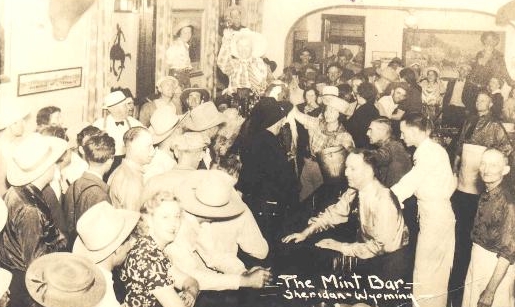
Interior, the Mint Bar, undated
Note, next to the gentleman in the black hat and shirt,
and next to the young lady with
the bucket, is a horse.
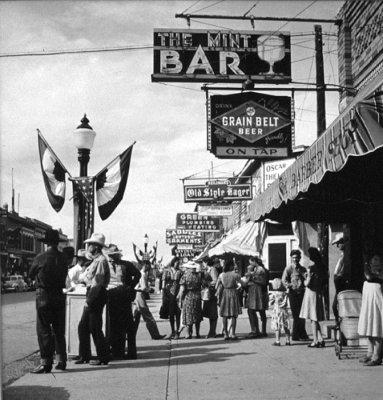
Left, The Mint, August 1941, photo by Marion Post Wolcott.
The Mint Bar, still in business at 151 N. Main St., was established in 1907.
The practice of riding horses into saloons was noted, with perhaps some sense of
disapprobation, by Theodore Roosevelt in his book Ranch Life and the Hunting Trail.
Roosevelt observed that cowboys "when drunk on the villainous whiskey" would "cut mad antics" such
as riding their horses into the saloons. Indeed, the custom continues. A website
devoted to the Town of Ten Sleep
notes, with apparent pride, that photographs have
been taken of cowboys and their horses in the town's two saloons. One of Webmaster's son's
fraternity brothers allegedly modernized the practice by driving his pickup truck into
a saloon
During prohibition the Mint Bar continued to
operate, although quietly. Upon the repeal of prohibition it officially reopened
and operated slot machines, roulette and gaming tables in the back. In the
late 1940's it was remodeled to the style seen in the color photo below right.
As noted above, the Mint Bar is still in business.
Its interior decorations include 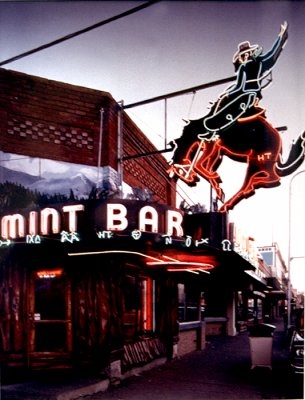 a 8 ft. 4 inch long rattlesnake hide having
37 buttons on its tail, a copy of Russell White Bear's map of the Custer
Battle and photos by Charles J. Belden. Its interior has also been featured in a French
television commercial. a 8 ft. 4 inch long rattlesnake hide having
37 buttons on its tail, a copy of Russell White Bear's map of the Custer
Battle and photos by Charles J. Belden. Its interior has also been featured in a French
television commercial. "Grain Belt" Beer, featured on the sign,
has no particular relationship to Sheridan or Wyoming.
It was brewed in Minneapolis and later in Omaha. Its history dates back to 1850,
when John Orth, a German immigrant commenced brewing in Minneapolis.
In 1893, the brand name was adopted. The original brewery closed in 1976, although
the brand name still continues. Sheridan did, however, have its own brewery, as
indicated in the photo further down the page of the Stockmen's Saloon in Ranchester.
The Sheridan Brewery, maker of "Sheridan Export" and "Sheridan Pale" remained in
business from 1885 to 1954.
The Mint, 1979, photo by Bill Ganzel.
Nebraska photographer Bill Ganzel in the 1970's undertook to retake many of the
photographs of the people and places depicted in the Farm Security Administration
photographs. His photos ultimately appeared in his book, Dust Bowl Descent,
University of Nebraska Press, Lincoln, 1984.
The Sheridan area, like most of Wyoming, has its share of ghost towns. Ghost towns in the area include
Acme, Dietz, Kooi, and Monarch pictured immediately below. Monarch was founded in 1903 when
the Chicago, Burlington and Qunicy reached the area. At its peak it had a
population of approximately 800.
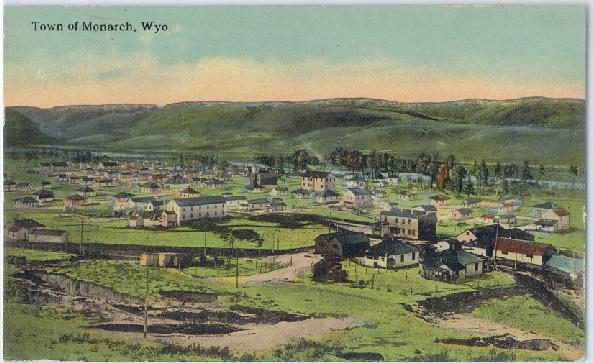
Monarch, Wyo., 1914
Monarch, a coal mining town, was located 10 miles northwest
of Sheridan and today consists of several buildings and the cemetary.
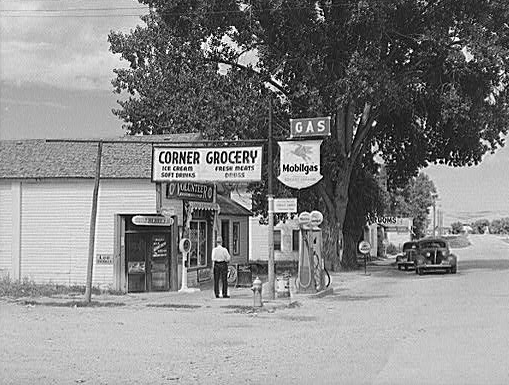
Ranchester, 1941, photo by Marion Post Wolcott
Photographs taken by the Farm Security Administration always seemed to make things look
slightly more bleak than they were in fact. Ranchester did consist of more than
a gas station and the Stockmen's Saloon pictured below. Note the fire hydrant indicated
the presence of a central water system for the town. Actually, at one time the town was
quite prosperous. S. H. Hardin, after whom Hardin, Montana is named, had his home
in Ranchester. The Chicago, Burlington and Quincy arrived in 1896. With the need by the
railroad for railroad ties, Omaha investment banker John A. McShane (1850-1923) established a mill in Ranchester
which became the principal source of railroad ties for the Burlinton System. McShane in addition to
being President of the McShane Lumber Company which had interests ranging from East Texas to
Wyoming, was also a shareholder in the Bay State Cattle Co., the Creighton-McShane Oil Co.,
and served as both a representative and senator in the
Nebraska State Legislature. He was elected in 1887 to one term to the United States House of
Representatives. McShane, Texas, now a ghost town, was named after him.
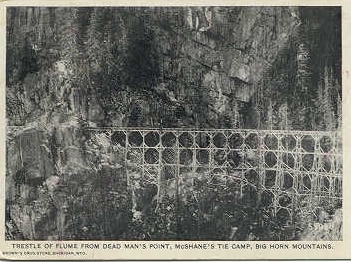 Flume for McShane's Tie Camp, Big Horn Mountains, at Deadman's Point
Flume for McShane's Tie Camp, Big Horn Mountains, at Deadman's Point
McShane, as a young lad of 22, came to Wyoming Territory from Omaha in 1872 and was employed by his uncle,
John A. Creighton, on the Creighton Ranch on Horse Creek north of Cheyenne.
After he had been in Creighton's service for about two years Indians
raided the ranch. McShane was there alone with a 15 year old boy who was killed by the
raiders. McShane came out with his hands up. The Indians forced McShane to cook food for them and,
upon completion of their repast, stripped McShane of his clothes, beat him into a stupor, and stole all the horses.
McShane then had to walk naked, eluding the Indians, to the next ranch which was then under
seige by the Indians. Shortly thereafter McShane returned to Omaha.
But we digress. The railroad tie operation was regarded as one of the marvels of the age. The
tie camp was in the Big Horn Mountains. As depicted above, an elaborate system of flumes was constructed to carry the
ties to the Tongue River at Dayton where they were then floated to the mill at
Ranchester. The operation brought prosperty to the area until the operation closed after a
fire. Today Ranchester is a bedroom community for Sheridan.
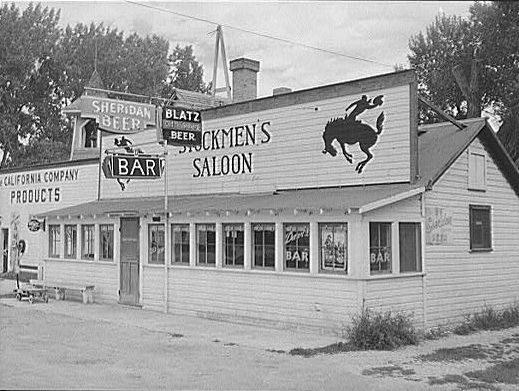
Stockman's Saloon, Ranchester, August 1941, photo by
Marion Post Wolcott
The use of the "bucking horse" logo in Wyoming, as depicted on the saloon, dates back to
World War I when used by Wyoming troops. It is supposedly based on a real horse and rider, the
horse, "Steamboat," competed in rodeos between 1901 and 1914 when he became infected
with blood poisoning as a result of contact with a barbed wire fence during a thunderstorm.
|